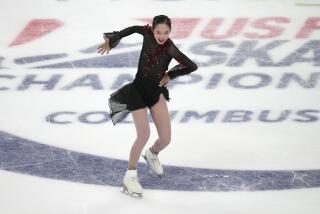World Figure Skating Championships : The Need for Compulsory Competition Is Questioned
- Share via
CINCINNATI — If anyone needed an excuse to favor the elimination of compulsory figures from the World Figure Skating Championships, they had one Monday. It took the men 7 1/2 hours to compete their compulsory figures at the Sabin Convention Center.
Defending champion Brian Boitano of Sunnyvale, Calif., had so much time between the first and second of his three figures that he ate lunch, took a nap and toured an exhibit.
Canadian Brian Orser, who finished second in the last three World championships to three different skaters, went to his hotel for four hours after his first figure, returned to the arena and still had to wait half an hour for his second figure.
The Soviet Union’s Alexandr Fadeev, the 1985 champion, had time to go home and back.
When it finally ended, an hour and a half behind schedule, Fadeev, as expected, had the lead. Boitano was second and Orser third.
The men’s competition will continue tonight at Riverfront Coliseum with the short program.
The compulsories were anything but a short program.
“It’s hard to kill time,” Boitano said. “You start convincing yourself the figures are more difficult than they are. The important thing is just to get away from it.
“I went to the exposition (Skater’s Market) so I could think about some different stuff. I don’t like my day to consist of 12 hours of figures.”
There is an on-again, off-again movement to eliminate the compulsories from World championships, although they probably would remain part of national and local meets.
When the sport began in 1888, it was a contest to see which skaters could draw the most elaborate figures on ice, which is the genesis of the name figure skating.
As recently as 1966, the figures counted for 60% of the skaters’ final scores.
In recent years, however, the figures have been deemphasized. They now are worth 30%, but, because of scoring changes after the 1980 Olympics, the winner of the compulsories has less of an advantage entering the final two phases of the competition, the short freestyle programs.
Unless someone has considerable expertise in the sport, watching the compulsories is like watching ice melt.
“This is seven hours that wouldn’t go over well on television,” said Linda Leaver, Boitano’s coach.
U.S. officials at one time were in favor of eliminating the figures, primarily because their skaters were historically bad in the compulsories.
In recent years, however, the U.S. position has changed.
Not only have U.S. skaters become more proficient in compulsories, rink operators and coaches who charge by the hour believe they would lose money if there was less emphasis on figures.
“If you cut the figures out, we’d lose 50% of our jobs, and rinks would lose 50% of their rink time,” Carlo Fassi, coach at the Broadmoor World Arena in Colorado Springs, told the Cincinnati Enquirer.
“It would be a disaster financially for many rinks. Figures are practiced from 5 until 9 in the morning. That ice is difficult to sell.”
Eastern Bloc officials are believed to favor the change because of the limited amount of ice time in their countries.
The question could be on the agenda this May at the International Skating Union’s congress.
More to Read
Go beyond the scoreboard
Get the latest on L.A.'s teams in the daily Sports Report newsletter.
You may occasionally receive promotional content from the Los Angeles Times.






